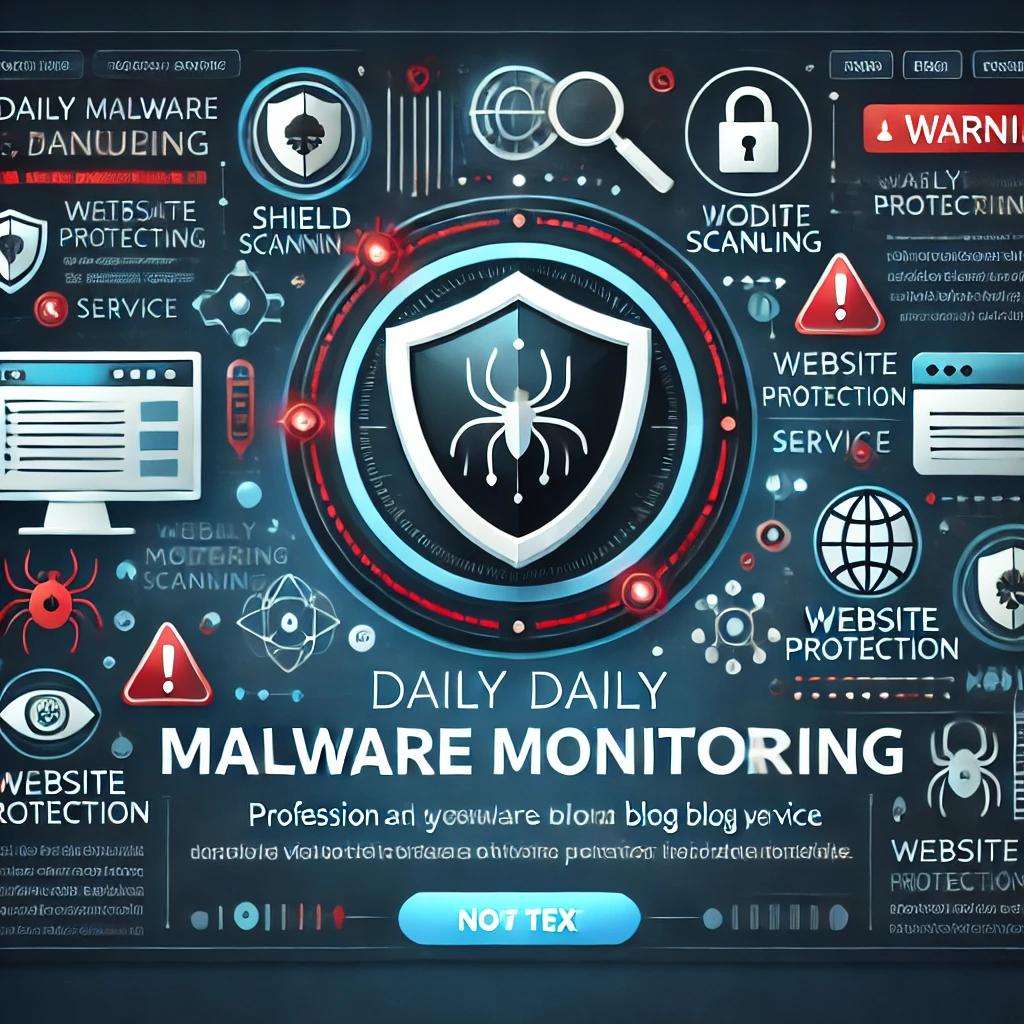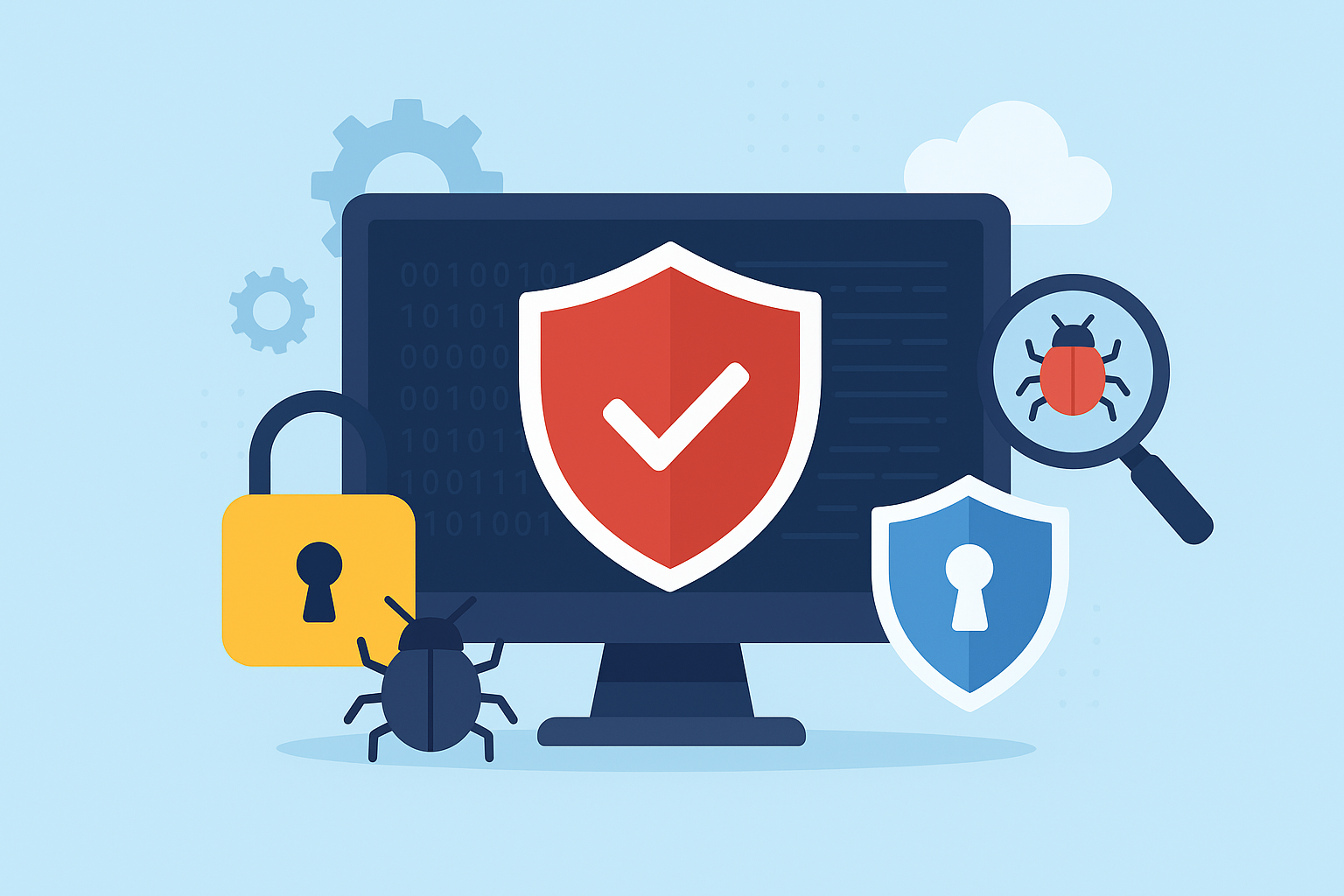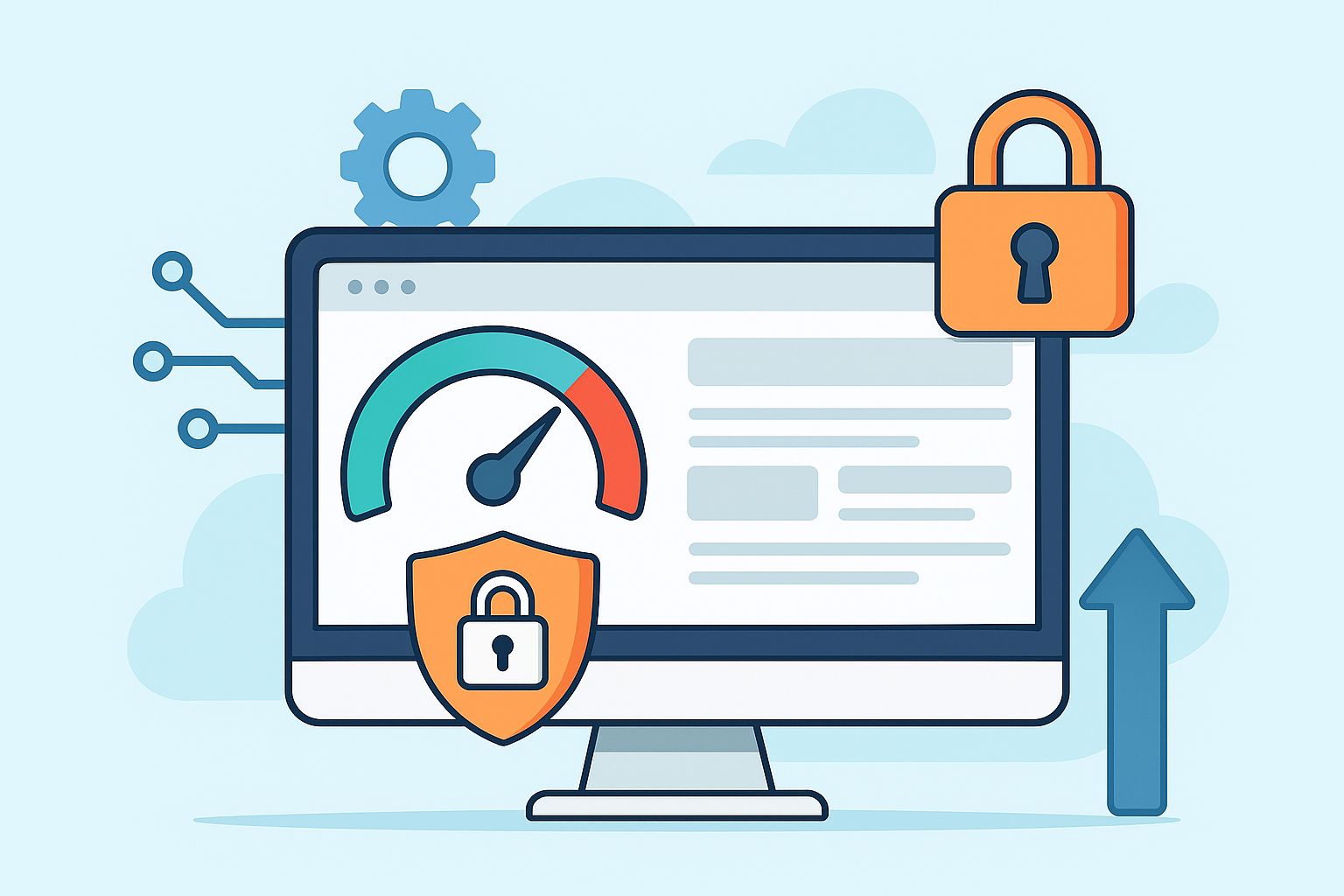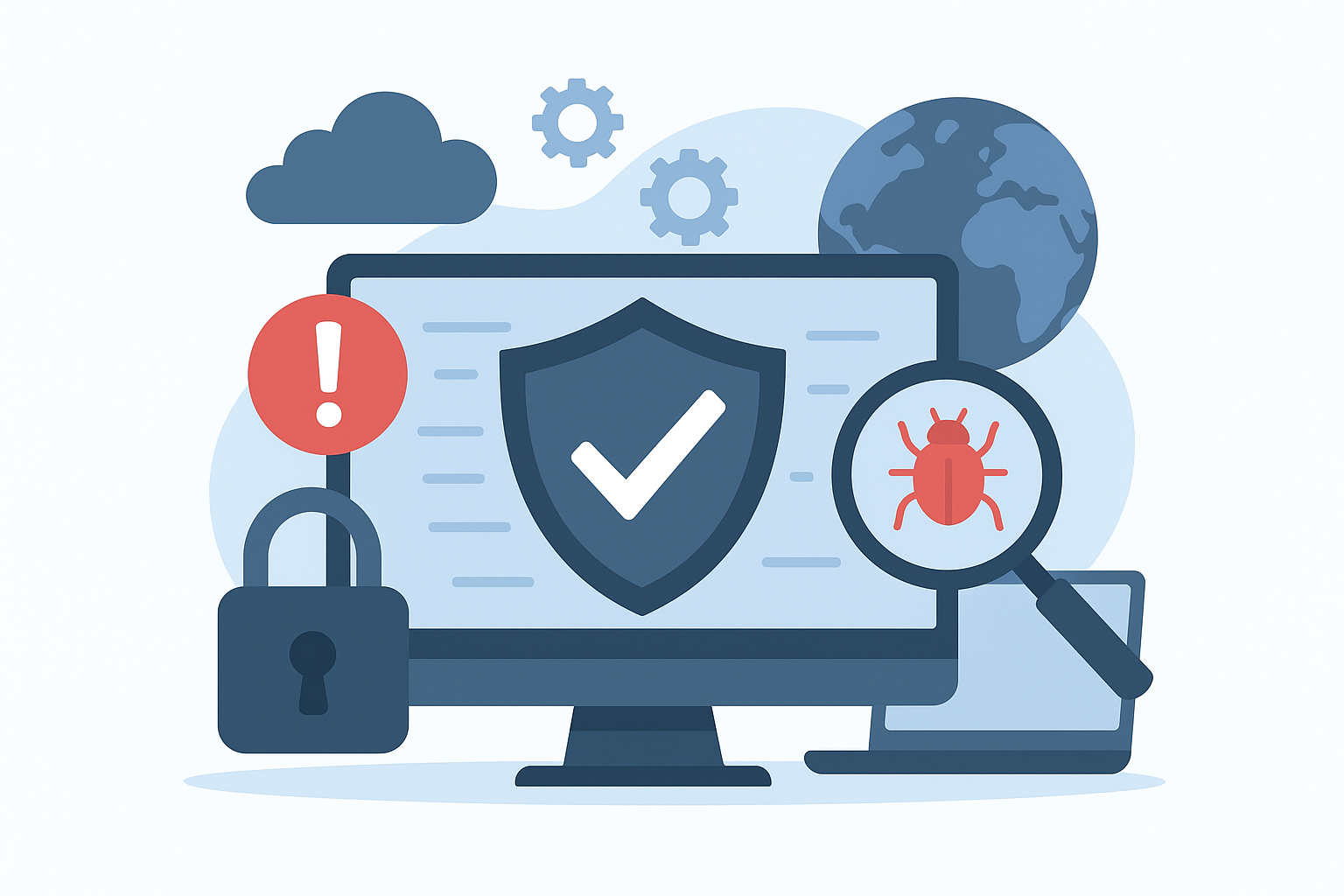Introduction: Why Daily Malware Monitoring Matters
In an increasingly digital world, where businesses operate almost entirely online, your website is more than just a marketing tool—it’s a vital part of your operations. But with this convenience comes a dark side: malware attacks are more frequent, sophisticated, and damaging than ever.
That’s where Daily Malware Monitoring Services come into play. These services are designed to continuously monitor your website, detect malicious threats in real time, and help you eliminate them before they can cause any damage.
If you’re serious about your website’s health, performance, and security, daily monitoring is not a luxury—it’s a necessity.
What Is Malware and How Does It Affect Your Website?
Malware (short for “malicious software”) refers to any software intentionally designed to cause damage to a computer, server, or network. For websites, malware can come in many forms:
- Viruses and worms
Viruses and worms are among the most well-known types of malware. A virus is malicious code that attaches itself to clean files or programs and spreads when that file is opened or executed. It can corrupt, delete, or steal data, and may even cause complete system failure. Worms, on the other hand, are standalone programs that replicate themselves and spread across networks without any human interaction. They can quickly infect multiple systems, consuming bandwidth, slowing down servers, and leaving systems vulnerable to further attacks.
- Backdoors and trojans
Backdoors and trojans are stealthy forms of malware designed to give attackers unauthorized access to a system. A trojan disguises itself as a legitimate program or file to trick users into installing it. Once installed, it can open a backdoor — a hidden pathway that allows hackers to enter and control the system remotely. This access can be used to steal sensitive data, install more malware, or hijack the system for other attacks. Unlike viruses or worms, trojans typically don’t replicate themselves but are just as dangerous due to their deceptive nature.
- Phishing scripts
Phishing scripts are used to trick users into revealing personal or financial information by mimicking legitimate websites, login forms, or communications. These scripts are often injected into vulnerable websites or delivered via email and social media. When users enter their details — such as usernames, passwords, or credit card numbers — the information is captured and sent to the attacker. Phishing is one of the most common ways hackers gain access to accounts and can lead to identity theft, financial loss, or data breaches.
- SEO spam and redirects
SEO spam and redirects are malicious techniques used to hijack a website’s traffic and reputation. In SEO spam, hackers inject spammy keywords, fake pages, or outbound links into a website to manipulate search engine rankings — often promoting shady products or services. Redirects force users to leave the legitimate site and land on harmful or irrelevant websites instead. This not only damages the trustworthiness of the affected site but can also result in blacklisting by Google, leading to a significant drop in traffic and revenue.
- Ransomware and spyware
Ransomware and spyware are particularly harmful forms of malware with serious consequences. Ransomware encrypts the victim’s files and demands a ransom (usually in cryptocurrency) to unlock them. This can completely paralyze businesses and result in permanent data loss if backups are unavailable. Spyware, meanwhile, operates silently in the background, collecting sensitive information such as keystrokes, login credentials, and browsing habits. This data can then be sold or used for identity theft, corporate espionage, or financial fraud.
How malware impacts your website:
- Website defacement or redirection
Website defacement or redirection is a clear sign that your site has been compromised. Defacement involves attackers replacing your website’s content with their own messages, which can range from political propaganda to offensive images or hacker signatures. This not only damages your brand’s image but also alerts visitors that your site is unsafe. In redirection attacks, users are secretly redirected to malicious or irrelevant third-party websites, such as fake login pages, adult content, or scam sites. Both types of attacks severely harm your credibility and can drive potential customers away.
- Loss of sensitive data
Loss of sensitive data is one of the most serious outcomes of a website compromise. Hackers often target databases to steal customer information, login credentials, payment data, or proprietary business content. This can lead to identity theft, financial fraud, legal liability, and serious reputational damage. If your site stores personal or financial data and lacks proper security measures, a single breach can cost you thousands in recovery, fines, and lost business.
- Blacklisting by Google
Blacklisting by Google happens when your site is detected as unsafe or compromised. Google regularly scans websites for malware, phishing scripts, spam, and other malicious content. If a threat is found, your site may be blacklisted, meaning it will be flagged in search results with a “This site may harm your computer” warning — or even removed entirely. This drastically reduces your site’s visibility and can lead to a massive drop in organic traffic until the issue is resolved and the site is re-evaluated.
- Drop in search rankings
Drop in search rankings is a common side effect of malware infections and SEO spam. When Google’s algorithms detect malicious content, broken code, or unusual behavior (like hidden redirects or keyword stuffing), your site’s ranking drops significantly, often without warning. Even after the issue is fixed, it can take weeks or months to regain lost positions. This directly impacts your SEO performance, brand visibility, and inbound traffic, making it harder for users to find your website online.
- Decreased user trust and conversions
Decreased user trust and conversions is an inevitable result of a hacked or compromised website. Visitors who see a warning, experience a redirect, or notice strange content will likely leave immediately — and many won’t return. This leads to a decline in engagement, purchases, and sign-ups, affecting your overall revenue and business growth. Worse, word of mouth or online reviews may spread the issue, further damaging your brand’s reputation.
Even a few hours of undetected malware can cost you thousands in lost traffic, revenue, and reputation.
What Is a Daily Malware Monitoring Service?
A Daily Malware Monitoring Service is a proactive security solution that regularly scans your website (usually every 24 hours or even more frequently) to:
- Detect known and unknown malware.
Detect known and unknown malware is a core function of modern website security services and malware scanners. These tools are designed to identify both well-documented (known) threats—such as widely distributed viruses, trojans, and phishing scripts—as well as emerging or unknown malware that hasn’t yet been cataloged in public threat databases. Advanced detection techniques like heuristic analysis, behavior-based scanning, and machine learning allow these systems to flag suspicious code patterns or behaviors even if they haven’t been previously recorded. This proactive detection significantly reduces the risk of long-term infections and data breaches.
- Monitor suspicious activity or unauthorized changes.
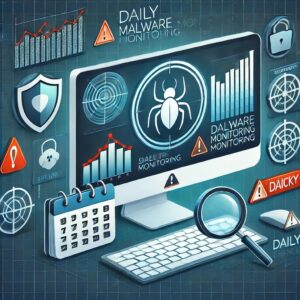 Monitor suspicious activity or unauthorized changes refers to the continuous surveillance of your website’s files, database, user accounts, and server environment. A reliable monitoring system can detect unexpected modifications to core files, unusual login attempts, injections of malicious code, or new unknown users added to admin panels. By keeping a constant eye on backend activity, these systems help prevent silent infections and provide insight into how and when a compromise may have occurred. This level of monitoring is crucial for identifying vulnerabilities and acting before attackers do serious damage.
Monitor suspicious activity or unauthorized changes refers to the continuous surveillance of your website’s files, database, user accounts, and server environment. A reliable monitoring system can detect unexpected modifications to core files, unusual login attempts, injections of malicious code, or new unknown users added to admin panels. By keeping a constant eye on backend activity, these systems help prevent silent infections and provide insight into how and when a compromise may have occurred. This level of monitoring is crucial for identifying vulnerabilities and acting before attackers do serious damage.
- Alert you immediately upon detecting threats.
Alert you immediately upon detecting threats is essential for timely response and mitigation. Security services often provide real-time alerts via email, SMS, or dashboard notifications the moment suspicious activity is detected. This instant notification allows website owners or security teams to react quickly—whether by blocking access, investigating the issue, or beginning the cleanup process. Without timely alerts, malware can remain active on a site for days or weeks, leading to deeper infections, blacklisting, or data loss.
- Automatically or manually remove the threat, depending on the service.
Automatically or manually remove the threat, depending on the service refers to how the malware is handled once it’s detected. Some advanced security platforms offer automatic malware removal, where the system immediately isolates and removes infected code or files without human intervention—ideal for rapid response. Others may provide manual removal services, where experienced professionals review the infection, clean the system carefully, and ensure no backdoors or lingering threats remain. The best services combine both approaches, giving users the flexibility to choose based on their preference, budget, and security policy.
These services act like your website’s security guard—patrolling 24/7 to catch threats before they turn into disasters.
Why You Need Daily Malware Monitoring (Not Just Monthly)
A lot can go wrong in a single day. Hackers don’t wait for your monthly audit to inject malicious scripts. That’s why daily malware monitoring is essential.
Key benefits of daily scans include:
- Real-time detection and instant alerts.
Real-time detection and instant alerts ensure that any signs of malware or suspicious behavior are identified the moment they occur. This allows website owners or administrators to act immediately before threats can spread, cause harm, or go unnoticed for days or weeks. Real-time monitoring tools continuously scan your website for changes, vulnerabilities, or malicious code, and send instant notifications via email, SMS, or dashboard alerts. This rapid awareness and response capability is crucial for minimizing damage and maintaining operational continuity.
- Prevention of SEO damage due to blacklisting.
Prevention of SEO damage due to blacklisting is a major advantage of early malware detection. When Google or other search engines detect malicious activity on your website, they may blacklist your domain or label it with a security warning — drastically hurting your organic traffic and online reputation. With daily or real-time monitoring, threats can be resolved before they’re discovered by search engines, helping you protect your SEO rankings, brand credibility, and online visibility. Avoiding blacklisting also means fewer delays in recovery and less lost revenue from search-related leads.
- Faster response and cleanup, reducing downtime.
Faster response and cleanup, reducing downtime is critical for business continuity. The longer malware stays undetected on your website, the more it can disrupt user experience, compromise data, or damage your infrastructure. Real-time monitoring allows for immediate threat identification, which accelerates investigation, containment, and removal. As a result, your site remains operational or returns online quickly, minimizing disruptions to your customers and preserving revenue. Less downtime means higher reliability, especially for e-commerce, SaaS, or service-based businesses that rely on continuous uptime.
- Customer trust through reliable performance.
Customer trust through reliable performance is one of the most valuable long-term benefits. Users expect secure, stable websites — and even a single infection, redirect, or warning can destroy their confidence in your brand. By keeping your website clean and responsive, you show visitors that their privacy, safety, and experience matter. This trust translates into higher engagement, more conversions, and greater customer loyalty over time. Consistent performance also improves professionalism and brand image, which are critical for attracting and retaining clients.
- Reduced risk of data theft, fraud, or ransomware attacks.
Reduced risk of data theft, fraud, or ransomware attacks is the ultimate goal of malware monitoring and security services. By detecting threats early, you prevent attackers from stealing sensitive customer data, planting spyware, or locking down your files for ransom. This proactive defense saves you from potential legal issues, financial losses, and reputational damage that can occur after a data breach. Implementing ongoing monitoring and response systems significantly lowers your overall cybersecurity risk, providing peace of mind for both you and your customers.
Just like you wouldn’t wait a month to update your antivirus software, don’t wait to scan your website.
How Daily Malware Monitoring Works
At its core, daily monitoring combines automated scans, threat intelligence, and sometimes manual verification to ensure comprehensive protection.
Here’s how it typically works:
- Website is scanned every 12–24 hours.
Website is scanned every 12–24 hours to ensure timely detection of any malicious activity. These regular scans are designed to catch threats shortly after they appear, minimizing the window of vulnerability. By performing automated scans once or twice a day, security systems ensure that even if new malware is injected between scans, it won’t go unnoticed for long. This consistent monitoring schedule strikes a balance between system resource usage and security, keeping your site protected without slowing it down.
- Files, code, and databases are checked for anomalies.
Files, code, and databases are checked for anomalies during each scan. The system inspects core files, plugin code, theme scripts, and database content for any unexpected changes, unauthorized injections, or suspicious scripts. Anomalies could include hidden iframes, base64-encoded payloads, unauthorized admin users, or unfamiliar code patterns. This comprehensive inspection helps identify not just known malware but also potential zero-day threats or early indicators of compromise, such as altered configuration files or new unknown scripts.
- Comparison with threat databases to detect known malware.
Comparison with threat databases to detect known malware is a key part of the scanning process. The security system checks the website against large, continuously updated databases of malicious signatures, file hashes, and behavior patterns. This enables fast and accurate identification of widely recognized threats like trojans, phishing scripts, JavaScript injections, SEO spam, or ransomware. Because threat databases are updated in real-time, even new malware variants are detected shortly after they’re discovered in the wild.
- Alerts are sent if malware is found.
Alerts are sent if malware is found, ensuring that the website owner or security team is informed immediately. These alerts are typically sent via email, SMS, or through the service dashboard. The notification includes details about what was found, where it was located (file path, URL, etc.), and what type of threat it is. Immediate alerts allow for a rapid response, reducing the time malware can remain active on your site and helping prevent further damage like blacklisting or data theft.
- Optionally, malware is removed automatically or manually.
Optionally, malware is removed automatically or manually, depending on the service plan and configuration. Automatic removal tools can isolate and clean infected files as soon as a threat is detected, ensuring minimal downtime and fast recovery. In more complex cases, or for those who prefer a hands-on approach, manual malware removal may be performed by security experts who thoroughly clean the infection while preserving important data. Some services also allow users to review threats before taking action, giving full control over the remediation process.
- A report is generated for record-keeping and analysis.
A report is generated for record-keeping and analysis after every scan or malware removal action. This report includes a summary of the scan, any issues detected, threats removed, and recommendations for further action. These reports are useful for compliance, audits, and internal tracking, and can also be shared with developers or IT staff to strengthen future defenses. Keeping a record of security events ensures you stay informed about your website’s health and allows for better planning and incident response.
These scans are often lightweight and do not affect your website’s performance.
Features to Look for in a Reliable Malware Monitoring Service
Not all malware monitoring tools are created equal. A great service should offer:
- 24/7 automated scanning
24/7 automated scanning ensures that your website is constantly monitored for malicious activity, without any gaps. This around-the-clock protection means that threats can be detected shortly after they appear, drastically reducing the time they have to cause damage. Automated systems scan files, databases, and code structures regularly—often every few hours—providing proactive defense without requiring manual input.
- Zero-day malware detection
Zero-day malware detection targets new, previously unknown threats that haven’t been added to traditional malware databases yet. Using behavior-based algorithms and heuristic analysis, these systems can detect suspicious actions or code patterns that resemble malware—even if the exact signature is not known. This advanced detection is crucial in defending against modern cyber threats that evolve rapidly to avoid traditional scanners.
- Threat intelligence integration
Threat intelligence integration means the malware detection service is connected to a global database of real-time cybersecurity data. It pulls from thousands of sources including blacklists, security research labs, and peer networks to stay updated on the latest attack methods, malicious IPs, URLs, and file signatures. This collective intelligence boosts accuracy and helps protect your site against emerging threats.
- Manual analysis options
Manual analysis options allow human security experts to step in when needed. While automated systems handle most issues, sometimes a professional review is essential—especially for complex infections or false positives. Expert analysis ensures the malware is thoroughly removed without harming critical site files and also provides tailored recommendations for long-term security.
- Detailed malware reports
Detailed malware reports are provided after each scan or cleanup process. These reports outline the nature of the threat, where it was found, the action taken, and the potential impact. They’re useful for compliance purposes, client transparency, and ongoing security auditing. You’ll have a clear record of every incident, along with insights to help prevent future attacks.
- Automatic removal or expert cleanup
Automatic removal or expert cleanup gives users flexibility in how threats are handled. For basic or known infections, automatic tools can instantly remove malware without manual intervention. For more serious or custom-coded malware, expert cleanup is available—ensuring thorough and careful removal that won’t compromise your website’s functionality.
- Google blacklist monitoring
Google blacklist monitoring helps ensure that your site stays in Google’s good graces. If malware is detected and your site gets blacklisted, it can disappear from search results or display warning messages to users. Regular monitoring alerts you the moment blacklisting occurs, allowing for fast cleanup and resubmission to Google, minimizing SEO and trust damage.
- Change detection in core files
Change detection in core files involves scanning your CMS (e.g., WordPress) core files for unauthorized alterations. Hackers often target these files to inject malicious scripts or create backdoors. By detecting changes early, you can isolate and remove malicious code before it compromises your entire site.
- Real-time alerts
Real-time alerts notify you the instant suspicious activity or malware is detected. Whether through email, SMS, or dashboard notifications, these alerts allow you to take immediate action. The quicker you respond, the less likely your visitors will be exposed or your data will be stolen.
- Firewall integration
Firewall integration adds an extra layer of protection by blocking malicious traffic before it even reaches your website. It works alongside malware detection by filtering out known bad IP addresses, blocking bots, preventing brute force attacks, and stopping attempted exploits in real time. This proactive security barrier significantly reduces the chances of infection in the first place.
At FixHackedSite, we ensure all of these features are baked into every monitoring package.
Malware Types Detected by Monitoring Tools
Modern malware monitoring services can detect a wide variety of threats:
- JavaScript malware – Injected into site code to redirect users.
JavaScript malware is malicious code injected directly into your website’s JavaScript files. It often redirects users to phishing sites, malicious downloads, or scam pages without their knowledge. Attackers typically embed the script in headers, footers, or third-party plugins. Once active, it silently manipulates browser behavior, potentially stealing user data or damaging your site’s reputation.
- PHP-based backdoors – Allow attackers ongoing access.
PHP-based backdoors are hidden scripts placed in your server’s PHP files that allow hackers continuous remote access to your website. These backdoors enable attackers to re-infect the site, upload files, execute commands, or gain admin-level control even after you think you’ve cleaned the site. They’re often disguised as legitimate code and difficult to detect without a deep scan.
- SQL injections – Harmful code targeting your database.
SQL injections exploit vulnerabilities in your website’s input fields (like login forms or search bars) to execute harmful database queries. A successful SQL injection can expose user data, delete or modify content, and even grant full access to your database. This is one of the most common and dangerous types of web attacks.
- Malicious iFrames – Load unwanted third-party content.
Malicious iFrames are invisible frames embedded in your site that load external, dangerous content from other servers. These frames can redirect visitors, deliver malware, or display spam ads—often without the website owner’s knowledge. iFrames are commonly used in automated mass infections to spread threats across thousands of sites.
- SEO spam – Injected links for fraudulent SEO.
SEO spam involves injecting spammy or malicious links into your site’s content, often hidden from normal view. The goal is to manipulate search engine rankings for scam websites (like fake pharmacies or counterfeit stores). Google detects this and may blacklist or penalize your site in search rankings, harming your credibility and traffic.
- Crypto miners – Use your server’s resources to mine cryptocurrency.
Crypto miners hijack your server’s CPU to mine cryptocurrency for the attacker, usually by injecting JavaScript-based mining scripts. These scripts run in the background, consuming your server’s resources, slowing down your website, and potentially increasing your hosting costs. Visitors to your site may also experience performance issues or overheating devices.
- Ransomware – Locks your files and demands a payment.
Ransomware is a particularly severe threat where malicious software encrypts your website’s files and demands a ransom (usually in cryptocurrency) to restore access. If backups aren’t available or secure, this can result in permanent data loss. Ransomware often enters through vulnerable plugins, weak credentials, or infected uploads.
Daily scans help catch all of these early, so you’re not stuck dealing with the fallout later.
Integrating Daily Monitoring with Your Security Strategy
Daily monitoring should be a core part of your cybersecurity toolkit. Here’s how to integrate it effectively:
- Pair it with a web application firewall (WAF).
A Web Application Firewall (WAF) sits between your website and incoming traffic, filtering malicious requests in real-time. It blocks common threats like SQL injections, cross-site scripting (XSS), and brute force login attempts before they reach your server. When paired with malware monitoring, a WAF significantly reduces the risk of attacks and adds a proactive layer of defense.
- Run weekly manual security audits.
Automated scans are essential, but manual audits catch vulnerabilities that software might miss. Weekly audits involve checking for unfamiliar code changes, unusual admin logins, altered permissions, and plugin activity. These reviews ensure early detection of suspicious behavior and give you control over your site’s integrity.
- Keep plugins, themes, and CMS updated.
Outdated components are the most common entry point for hackers. Developers regularly release updates to fix vulnerabilities. If you delay updates, attackers can exploit known flaws. Make it a habit to check and update your WordPress, Joomla, or any CMS, along with all installed themes and plugins, as soon as updates become available.
- Use secure hosting and SSL certificates.
Secure web hosting offers enhanced protections like malware scanning, intrusion detection, and firewall services. Pair this with an SSL certificate, which encrypts data exchanged between your site and visitors. SSL is not only vital for protecting login credentials and user information—it’s also a ranking factor in Google search results.
- Regularly back up your site.
Even with top-tier security, no website is 100% immune. Regular backups ensure that if your site is compromised, you can restore it quickly without data loss. Use automated backup tools to schedule daily or weekly backups and store them securely off-site (e.g., on cloud storage or external servers).
- Train your team on security hygiene.
Your team can unintentionally create vulnerabilities—like using weak passwords, falling for phishing emails, or installing unauthorized plugins. Conduct regular training sessions to teach cybersecurity awareness, password management, update policies, and how to spot suspicious activity. A well-informed team is a crucial part of your website’s overall defense.
The goal is not just to react, but to build a system that prevents, detects, and recovers from threats with minimal damage.
Consequences of Not Monitoring Your Website Daily
Skipping daily malware monitoring can expose your website to devastating risks:
- Loss of SEO rankings after being blacklisted by Google.
When Google detects malware on your site, it blacklists your domain to protect users. This means your website won’t appear in search results and will display a warning message like “This site may harm your computer.” As a result, your SEO rankings plummet, organic traffic drops, and it can take weeks or months to regain your position—even after the infection is removed.
- Data theft and potential legal issues (e.g., GDPR fines).
Hackers often target websites to steal sensitive data such as customer names, emails, addresses, or even payment details. If your site handles personal or financial data, a breach may lead to legal consequences. Under laws like the GDPR or CCPA, failure to protect user data can result in hefty fines, lawsuits, and mandatory breach notifications.
- Defaced website, harming your brand’s image.
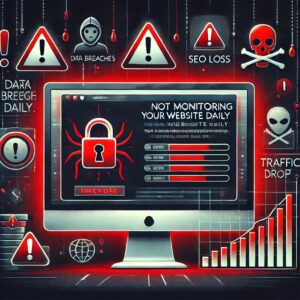 Website defacement involves hackers replacing your homepage or other pages with offensive content, propaganda, or malicious messages. This creates a terrible first impression for visitors and damages your brand’s credibility. Restoring the site may take time, and the damage to your reputation—especially if screenshots are shared—can be long-lasting.
Website defacement involves hackers replacing your homepage or other pages with offensive content, propaganda, or malicious messages. This creates a terrible first impression for visitors and damages your brand’s credibility. Restoring the site may take time, and the damage to your reputation—especially if screenshots are shared—can be long-lasting.
- Customer data leaks, resulting in loss of trust.
If hackers gain access to customer accounts or sensitive information, trust is broken. Your users may feel unsafe and stop using your services, unsubscribe from emails, or post negative reviews. In competitive industries, losing trust even once can permanently reduce customer retention and word-of-mouth referrals.
- Long downtime, costing revenue and sales.
Some attacks result in your site going offline for hours—or even days—especially if you don’t have proper backups or a response plan. For e-commerce stores or service-based sites, every hour of downtime means lost revenue, sales, and potential new clients. Downtime also affects your SEO, server health, and user experience.
- Spread of malware to visitors, damaging your reputation further.
If your infected website is not cleaned quickly, it may start distributing malware to your site visitors. This can occur via malicious scripts, drive-by downloads, or infected ad banners. Visitors affected by this may report your site, avoid returning, or file complaints. Your domain reputation suffers across email servers, social media, and browser databases.
It’s not a question of if your website will be attacked—but when. Daily monitoring ensures you’re ready when it happens.
FixHackedSite’s Daily Malware Monitoring Service
At FixHackedSite, we specialize in keeping your site clean, safe, and secure 24/7.
Our service includes:
- Automated daily malware scans
Your website is scanned automatically every 24 hours to detect both known and emerging threats. These scans check your site’s files, themes, plugins, and database for signs of infections like injected code, malicious scripts, or suspicious redirects. This helps identify issues before they harm visitors or affect SEO.
- Zero-day vulnerability detection
Zero-day threats are previously unknown security flaws that attackers exploit before developers can patch them. A strong malware monitoring system uses advanced algorithms and threat intelligence feeds to detect unusual behavior or code anomalies, catching these threats even if they’re not yet in threat databases.
- Instant alerts and reports
As soon as malware is detected or suspicious changes occur, you receive immediate alerts via email or dashboard notifications. A detailed report outlines the type of threat, location, severity level, and suggested next steps, allowing you to respond quickly before major damage is done.
- Manual malware removal by experts
Infections are not always straightforward to remove. This service includes professional manual cleanup by security experts, who thoroughly analyze your site’s code, identify the root cause, and eliminate all traces of malware. This ensures your site is fully clean and safe, avoiding repeat infections.
- Google blacklist monitoring and delisting support
If your site gets blacklisted by Google or flagged by antivirus tools, it can cause a loss of traffic and trust. This service monitors your blacklist status and assists in submitting reconsideration requests to Google and other entities to remove your site from blacklists quickly after cleanup.
- Firewall and patch recommendations
Beyond just removing malware, the service also recommends firewall configurations and software patches to strengthen your site’s defenses. This includes guidance on Web Application Firewall (WAF) settings, plugin/theme updates, and server-level fixes, reducing the chances of future attacks.
- Ongoing support and expert advice
You’re not left alone after cleanup. The service offers continuous support, allowing you to consult with security professionals for guidance on hardening your website, improving performance, and understanding threats. This long-term assistance gives you peace of mind and a security partner you can rely on.
Our clients trust us because we don’t just monitor—we protect. We don’t just detect—we clean and restore. And we don’t wait—we act fast.
Whether you’re running a WordPress site, Joomla, Magento, or custom platform—our tools and team have you covered.
Final Thoughts: Stay Safe Every Day, Not Just Someday
In today’s digital threat landscape, waiting to act is the biggest security risk of all. Daily malware monitoring helps you stay one step ahead, preserving your reputation, traffic, and business continuity.
If your site matters to you—and we know it does—then protecting it every day should be a top priority. Don’t settle for reactive security. Be proactive. Be smart.
FixHackedSite is here to help you monitor, protect, and secure your site—every single day.
📞 Need Help Now?
Contact FixHackedSite today for a free consultation or start your daily malware monitoring subscription now!
